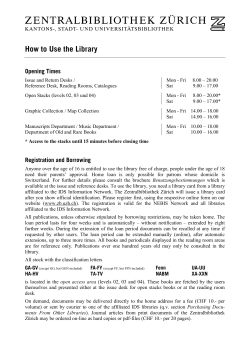
CITS2232 Assignment 2 - Sample Solution The University of Western Australia
CITS2232 Assignment 2 - Sample Solution School of Computer Science and Software Engineering The University of Western Australia April 12, 2012 Question 1: SQL Consider the following conceptual schema - the schema is described in the format used in the recommended reading text, which should be completely intuitive. Suppliers (sid: integer, sname: string, address: string) Parts (pid: integer, pname: string, colour: string) Catalogue (sid: integer, pid: integer, price: real) The “Suppliers” relation describes suppliers of parts which are described in the “Parts” relation. The “Catalogue” relation lists the prices for each part charged by the various suppliers. The keys for each relation are underlined. Write SQL queries to perform the following tasks (you do not need to use the aggregate functions). 1. List all suppliers of part number 12, cheapest first. SELECT Suppliers.sname FROM Suppliers, Catalogue WHERE Catalogue.sid = Suppliers.sid AND Catalogue.pid = 12 ORDER BY Catalogue.price ASC; Note: Whilst the query might give you by default the result set ordered in the ascending order (cheapest first). I did ask you to sort them in the ascending order, thus I did expect to see the ASC keyword used, especially in the exam situation. 2. List the names of all parts that come in both red and blue. SELECT PA.pname FROM Parts PA, Parts PB WHERE PA.pname = PB.pname AND PA.colour = ’red’ AND PB.colour = ’blue’; 3. List the name of every supplier that supplies a mauve-coloured part, with no duplicates. 1 SELECT DISTINCT Suppliers.sname FROM Suppliers, Parts, Catalogue WHERE Catalogue.sid = Suppliers.sid AND Catalogue.pid = Parts.pid AND Parts.colour = ’mauve’; 4. Find the price of the most expensive orange part. SELECT Catalogue.price FROM Parts, Catalogue WHERE Catalogue.pid = Parts.pid AND Parts.colour = ’orange’ ORDER BY Catalogue.price DESC LIMIT 1; Alternative answer accepted such as: SELECT Max(Catalogue.price) FROM Parts, Catalogue WHERE Catalogue.pid = Parts.pid AND Parts.colour = ’orange’ Question 2: ER Diagram Draw and ER Diagram for the following scenario, a real estate firm employs personnel and lists for sale properties that have owners. The following describes the organisation: • The firm is made up of several sales offices in various locations. Attributes of the sales office include an office number (identifier) and a location. • Each sales office has one or more employees. Each employee has an employee id (identifier) and a name. Each employee can only be assigned to one sales office. • Each sales office has one of its assigned employees designated as the manager of that office. 2 • The firm lists properties for sale. Each property has a property id (identifier), and location information consisting of a street address, the city, state, and post code. • Each property is exclusively listed with one sales office. Each sales office may have many properties listed, including none. • Each property has one or more owners. The percentage of ownership is an attribute of the relationship between an owner and the property. Each owner has an owner id (identifier) and a name. An owner may own one or more properties. 3 Note: For clarity of the diagram, all links of type “partial participation” are drawn here as dotted thin lines rather than the usual solid thin lines. Two relationships were tricky to categorise: 1. “An owner may own one or more properties”, represents a partial participation between the Owner entity and the Owns relationship, since strictly speaking they don´t have to own any. 2. there is a partial participation between the Sales office entity and the Works in relationship. The statement was “Each sales office has one or more employees”, but when there is only one employee, they are the manager by definition. Hence the total participation is enforced through the relationship with Manages. This subtle difference will get clarified when you consider how to implement the database in a RDBMS, as you will see later in Question 3. If you have full participation indicated from “Sales Office” to “Works In” it will still be marked as correct, but the above solution is preferred. Question 3: From ERD to Database Schema Implement your ER diagram from Question 2 as a database schema. Give the specification of each table you will implement. You can use the format used for describing the schema in Question 1 (you don’t have to provide the SQL DDL descriptions). The schema that best fits this problem domain is outlined below: Owner (o_id: integer PRIMARY KEY, o_name: string) Property (p_id: integer PRIMARY KEY, p_adress: string, p_city: string, p_zip: integer) Owns (p_id: integer FOREIGN KEY REFERENCES Property(p_id), o_id: integer NOT NULL FOREIGN KEY REFERENCES Owner(o_id), percent: real) 4 NOT NULL for o id in Owns ensures a property in Owns has at least one owner. However we can´t enforce that every property is within Owns using just key constraints. That requires CHECK, ASSERTIONS or TRIGGERS to check these things. More on this can be found in the Unit’s Lecture notes (See “Database - constraints and Triggers”, page: 430-444). In considering the Sales office, Lists and Property relations we note that the property can only appear once in the relationship and it MUST appear. This is a case where the key and participation constraints make it possible to embed the Lists relationship in the participating entities rather than in a separate table. The Sales office table is simple but we need to update the Property table. Since Property can only have one Sales office, we include the s id in the Property table (ensuring there can only be one), and make it NOT NULL (enforcing total participation). Sales Office (s_id: integer PRIMARY KEY, s_location: string) Property (p_id: integer PRIMARY KEY, p_adress: string, p_city: string, p_zip: integer, s_id: integer NOT NULL FOREIGN KEY REFERENCES Sales office(s_id)) The Sales office and Employee entities share two relationships. You could create two tables one for each relationship. If you do this then there is mutually exclusive e id values in the Manages and the Works in tables. That is, an employee either employed by or is a manager of a sales office. To work out who works in the office you would need to take the UNION of the two tables with the e id projected out. However taking into account the key and participation constraints means we can embed these relationships in the participating entities. In addition, as the Employee shares the same relationship with Sales office as did Property. There only be one Sales office for the Employee and the employee MUST be attached to an office. Thus as before we opt for this option. Employee (e_id: integer PRIMARY KEY, e_name: string, s_id: integer NOT NULL FOREIGN KEY REFERENCES Sales office(s_id)) 5 Manages is a one to one relationship. Similarly we embed the relationship in one of the entities, but now we have a choice where to do it. The best choice is given by the business logic. We can embed another FOREIGN KEY Sales office(s id) in Employee which identifies which sales office they are the manager off. Most will be NULL because most employees are NOT managers. However if that individual leaves, you have lost the manager connection entirely. You also can’t guarantee that two employees are BOTH managers of the same sales office. A better solution is to have the e id as a foreign key in the Sales office tables. There can only be one and you can enforce the participation constraint. Sales Office (s_id: integer PRIMARY KEY, s_location: string, e_id: integer NOT NULL FOREIGN KEY REFERENCES Employee(e_id)) You will need to use programmatic means (CHECK, ASSERTIONS or TRIGGERS) to ensure the (s id, e id) pairs in Sales office agree with (e id, s id) from Employee. 6
© Copyright 2025














